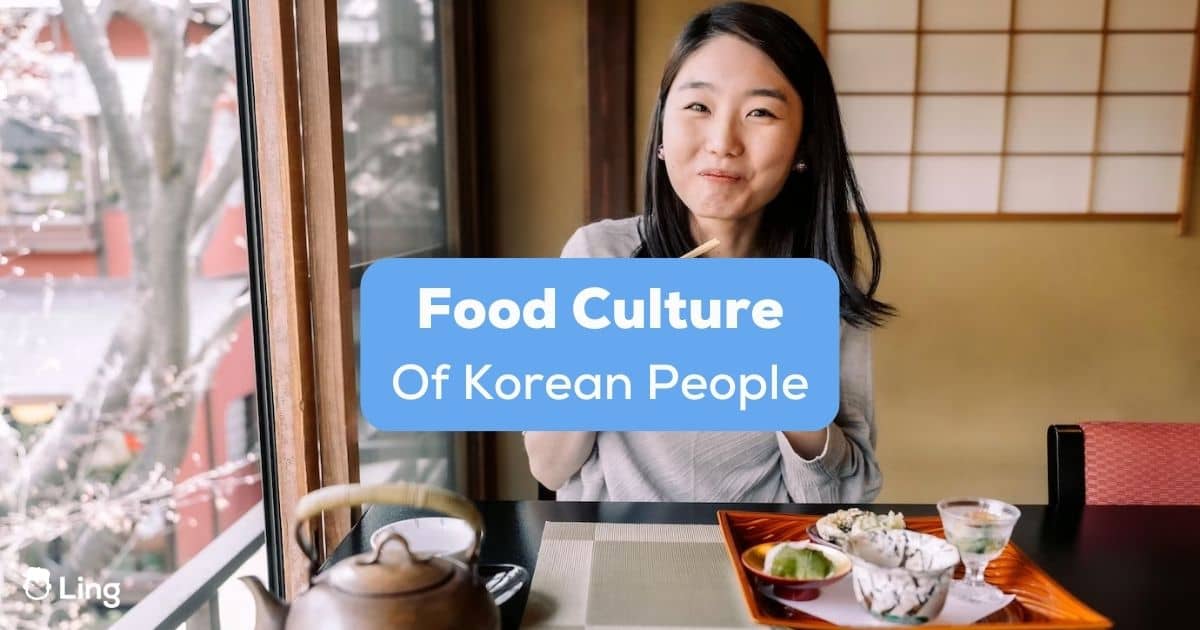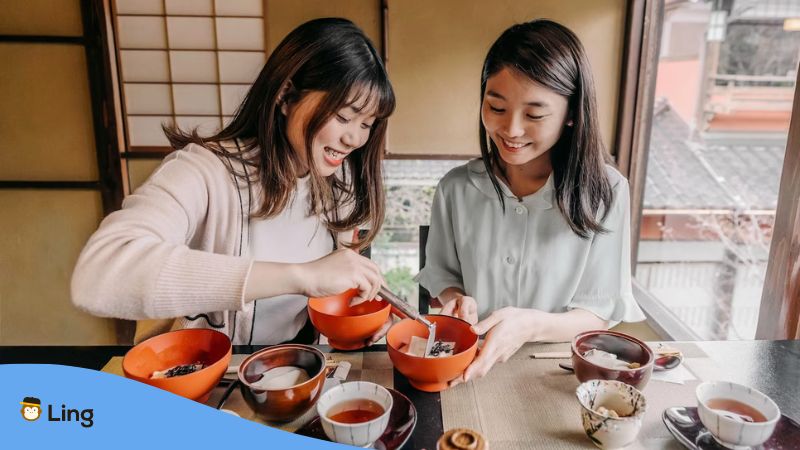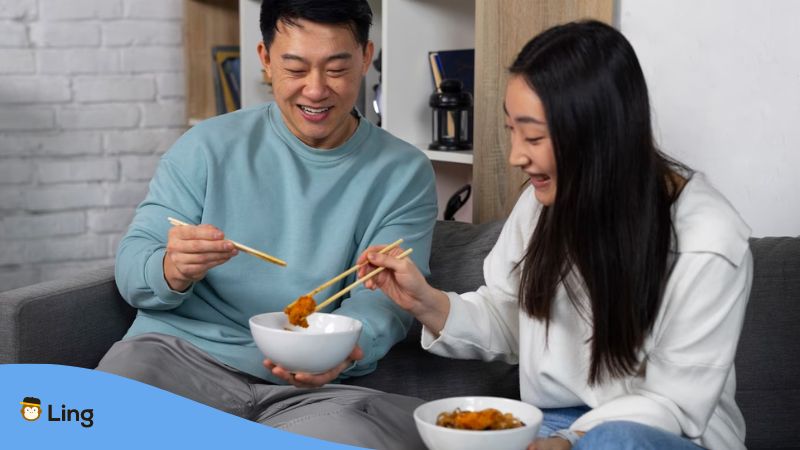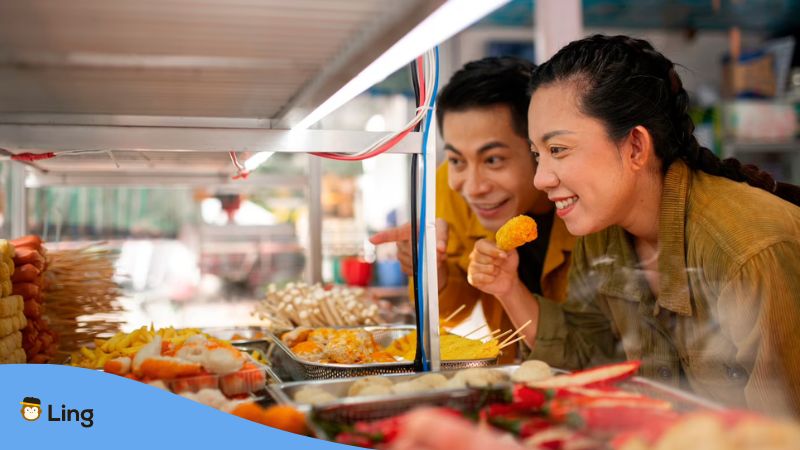
[ad_1]
Korean meals is greater than a meal. It’s a narrative. A narrative of custom, historical past, and values is woven into each chew.
In Korea, “음식 문화” (eumsik munhwa), or meals tradition, is an intimate a part of life. It’s an expression of affection, respect, and celebration.
However why is meals so very important in Korean tradition? It’s easy. It’s not nearly consuming.
Like studying the Korean language, it’s about connecting.
Stick with us. We’re about to uncover the wonders of the meals tradition of Korean individuals, one dish at a time. Let’s start!
The Roots Of Korean Meals Tradition
So, the place does this wealthy meals tradition of South Korea originate? Like a well-cooked stew, it’s a mixture of many components.
Historical past, geography, and faith have all stirred the pot, influencing Korean meals tradition uniquely.
Influences Of Historical past And Geography
Korea is a small peninsula in East Asia, surrounded by the ocean on three sides.
Are you able to think about the impression of this distinctive geography on its delicacies?
Seafood is considerable, and it’s no shock that it’s a major a part of the Korean eating regimen.
Ever heard of “해물” (haemul)? It refers to seafood in Korean, a star ingredient in lots of dishes.
However geography doesn’t simply imply the ocean.
The mountainous terrains of South Korea have influenced the meals tradition too.
Wild greens and herbs, usually known as “산나물” (sannamul), are frequent in Korean meals, because of the nation’s hilly landscapes.
Impression Of Confucianism And Buddhism
Confucianism and Buddhism have left a mark on Korean meals.
For starters, Confucianism emphasizes etiquette, even on the eating desk.
Respect for elders is paramount.
Ever questioned why youthful Koreans await the elders to eat first? Effectively, that’s Confucianism in motion.
Then again, Buddhism introduced veganism to the desk, actually!
Many Korean temples observe a vegan eating regimen, referred to as “사찰음식” (sachal eumsik) or temple meals.
It’s all about simplicity and mindfulness, influencing Korean delicacies past the temple partitions.

Staples Of Korean Delicacies
You possibly can’t discuss Korean delicacies with out mentioning its staples.
Rice, a plethora of aspect dishes referred to as ‘banchan,’ and the artwork of fermentation.
These components make Korean meals what it’s immediately.
The Centrality Of Rice
Rice, or “밥” (bap), is greater than only a grain in Korea. It’s the center of each meal.
In truth, the time period “bap” additionally means “meal” in Korean.
But it surely’s not simply plain white rice.
South Korea boasts a wide range of rice dishes, like “볶음밥” (bokkeumbap), or fried rice, and “주먹밥” (jumeokbap), or rice balls from a kneaded glutinous rice flour.
And let’s not overlook the ceremonious “떡국” (tteokguk), or rice cake soup, historically eaten throughout the Lunar New Yr.
Selection Of Banchan (Facet Dishes)
These are the little aspect dishes that accompany each Korean meal.
From spicy “김치” (kimchi), to savory “잡채” (japchae), to candy “단호박조림” (danhobak jorim) or braised pumpkin, the variability is staggering!
The most effective half?
Every banchan performs a novel position within the meal, balancing flavors and textures.
It’s like an orchestra on a plate, with every dish taking part in its half in concord.
Distinctive Fermentation Practices
Fermentation is a culinary approach as previous as time, however Koreans have really mastered it.
Take kimchi, as an illustration.
This fermented cabbage dish is a Korean staple meals, beloved for its spicy kick and well being advantages.
But it surely doesn’t cease there.
“된장” (doenjang), or fermented soy sauce and soybean paste, and “고추장” (gochujang), a fermented crimson chili paste, are two different stars of Korean delicacies.
These fermented Korean meals, referred to as “장” (jang), are important in Korean cooking.
They add depth and complexity to Korean dishes and are believed to advertise good well being too.
Conventional Korean Meals
Now, let’s talk about conventional Korean meals, from the usual composition of a meal to particular dishes and the position of meals in ancestral rites.
Normal Composition Of A Korean Meal
What’s in conventional Korean meals? The reply: stability and concord.
A normal meal, or “밥상” (bapsang), usually consists of cooked rice, soup, and an assortment of banchan.
However there’s extra to it.
It’s not nearly filling the desk. It’s about making a stability of flavors, textures, and even colours.
Ever observed the colours in a Korean meal?
Pink, inexperienced, yellow, white, black; it’s a feast for the eyes!
In Korean meals philosophy, these colours signify the 5 components of the universe. Fairly deep, proper?
This consideration to stability and concord is a testomony to the thoughtfulness of Korean delicacies.
Particular Dishes For Festivals And Celebrations
Meals takes middle stage throughout Korean festivals and celebrations.
Let’s take “설날” (Seollal), or Korean Lunar New Yr.
Households collect to make and revel in “떡국” (tteokguk), a soup made with thinly sliced conventional rice muffins.
It’s believed that consuming it provides a yr to your age!
Then there’s “추석” (Chuseok), or Korean Thanksgiving.
Right here, “송편” (songpyeon) steals the present.
These small rice muffins full of candy or savory fillings are as tasty as they sound!
Ancestral Rites And Meals
Lastly, we are able to’t talk about conventional Korean meals with out mentioning ancestral rites, referred to as “제사” (Jesa).
Meals performs an important position right here.
Households put together an expansion of Korean dishes that their ancestors loved and supply it to them in a ceremony.
It’s a method of honoring and remembering the deceased, reflecting Koreans’ deep respect for his or her ancestors.

Eating Etiquette And Social Elements
Alright, let’s change gears a bit. Let’s discuss eating etiquette and social points of Korean meals tradition.
Respect And Hierarchy At The Eating Desk
Respect is an enormous deal in Korean tradition, and it’s no completely different on the eating desk.
You would possibly discover, for instance, that the eldest particular person on the desk is the primary to eat.
This can be a signal of respect, a apply rooted in Confucian ideas of age-based hierarchy.
Ever heard the time period “선배” (sunbae)?
It refers to somebody senior to you, and in a Korean meal setting, their position is commonly acknowledged and revered.
Communal Eating And Sharing Meals
Communal eating is one other hallmark of the meals tradition of Korean individuals.
Have you ever ever observed the big dishes in the midst of the desk throughout a Korean meal?
That’s a typical sight!
Everybody shares these dishes, which fosters a way of neighborhood and togetherness.
The time period “정” (jeong) captures this sentiment of deep affection and bonding that Koreans usually affiliate with shared meals.
So, the subsequent time you’re sharing a bowl of “부대찌개” (budae jjigae) or military stew, bear in mind, you’re additionally sharing love and heat!
Ingesting Tradition And Bonding
Sure, Koreans love their “소주” (soju), however ingesting is about extra than simply the alcohol.
It’s a social exercise, an opportunity to bond and share tales.
It’s frequent for co-workers to go to a “호프집” (hof jip) or beer home after work to unwind and construct camaraderie.
Keep in mind, although, even in an off-the-cuff setting, respect guidelines.
As an example, when pouring a drink, the youthful or junior particular person makes use of each palms to point out respect to the older or senior particular person.
Small particulars, however they communicate volumes in regards to the tradition.

Korean Avenue Meals And Trendy Developments
Let’s take our style buds to the streets now. Avenue meals and fashionable tendencies, that’s what we’re speaking about.
Common Avenue Meals Gadgets
Avenue meals in Korea is a world of its personal. Take “떡볶이” (tteokbokki), as an illustration. It’s rice muffins in a spicy sauce.
Sounds easy? The style isn’t.
Then there’s “튀김” (twigim), a form of Korean tempura.
Assume greens, squid, and even seaweed, all deep-fried to perfection.
Oh, and let’s not overlook “핫도그” (hotteok). Candy pancakes full of honey, nuts, and cinnamon.
Affect Of Pop Tradition On Korean Meals
Have you ever heard of the Korean wave or “한류” (Hallyu)?
It’s introduced Korean tradition to the world. And meals is an enormous a part of it.
Korean BBQ or “고기구이” (gogi-gui), as an illustration, has turn into a worldwide sensation.
Who doesn’t love grilling meat at their desk, proper?
And let’s not overlook the “치맥” (chimaek) tradition.
It’s a combo of fried rooster and beer that turned synonymous with Korean meals tradition.
Due to widespread Korean dramas and Ok-pop music movies!
Fusion Developments And Worldwide Affect
Korean delicacies is evolving, mixing conventional flavors with worldwide influences.
Ever tried a Korean-Mexican taco? Or a bulgogi pizza?
They’re as scrumptious as they sound.
This mix of flavors and cuisines is a testomony to the dynamism and flexibility of Korean meals tradition.
Korean Meals Tradition Associated Vocabulary
Language, too, performs a task within the meals tradition of Korean individuals.
Let’s study some Korean phrases to make the expertise even richer.
Every phrase is a small window into the wealthy tapestry of Korean meals tradition.
So, the subsequent time you’re having fun with a Korean meal, bear in mind these phrases.
Use and savor them, simply as you’ll a scrumptious dish.
As a result of language, very like meals, is finest loved when shared.
Discover The Meals Tradition Of Korean Folks With Ling!
Feasting on the meals tradition of Korean individuals is an journey. It’s a wealthy mix of custom and taste. However think about, what in case your language expertise matched your style buds?
Right here’s the place the Ling app steps in!
It’s an interactive language-learning platform.
It presents real-life context classes in Korean and 60+ different languages.
With Ling, you’ll do greater than style the tradition. You’ll be a part of it.
Need to amplify your language and cultural journey?
Obtain the Ling app from Google Play and App Retailer.
Add a touch of language studying to your culinary exploration immediately!
[ad_2]